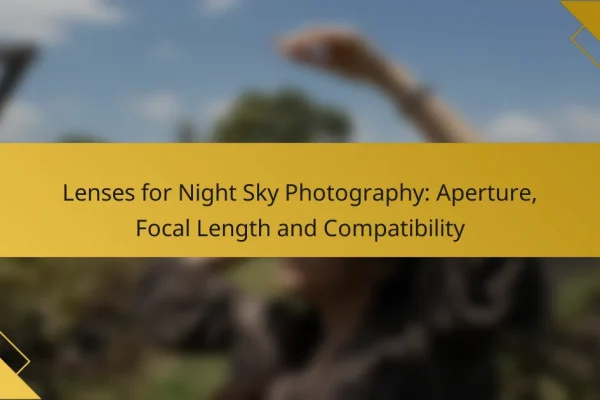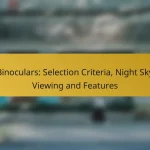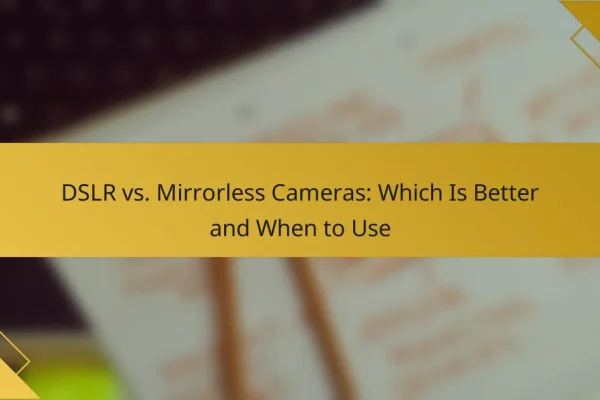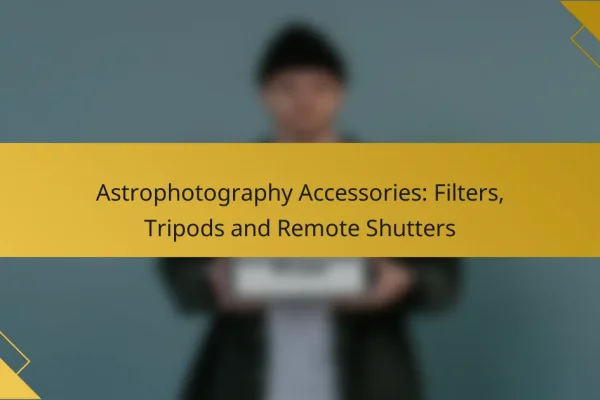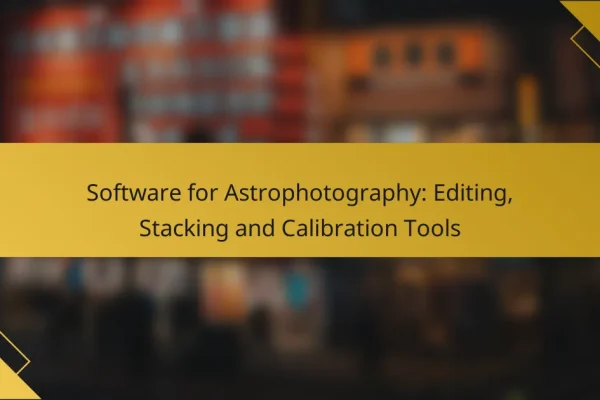What equipment do I need for astrophotography?
To get started with astrophotography, you’ll need a camera, a telescope or lens, a sturdy mount, and possibly filters. Each piece of equipment plays a crucial role in capturing high-quality images of celestial objects.
Cameras for astrophotography
For astrophotography, a camera with manual settings is essential. DSLRs and mirrorless cameras are popular choices due to their ability to handle long exposures and interchangeable lenses. Look for models with good low-light performance and the capability to shoot in RAW format for better post-processing flexibility.
Consider using a dedicated astrophotography camera, which often has features tailored for capturing faint objects. These cameras can be more expensive but provide superior performance in terms of sensitivity and noise reduction.
Telescopes for astrophotography
When selecting a telescope for astrophotography, consider the aperture size, which determines how much light the telescope can gather. Larger apertures are better for capturing faint objects but may be heavier and require more robust mounts. Refractors and reflectors are common types, each with its advantages.
Refractors offer sharp images and are generally easier to use, while reflectors provide larger apertures at a lower cost. Choose a telescope that matches your photography goals, whether you’re focusing on planets, nebulae, or galaxies.
Mounts for astrophotography
A stable mount is crucial for astrophotography, as it keeps your camera or telescope steady during long exposures. Equatorial mounts are preferred for tracking celestial objects as they rotate with the Earth’s movement, allowing for longer exposure times without star trails.
Consider the weight capacity of the mount to ensure it can support your camera and telescope setup. Look for mounts with built-in tracking capabilities and, if possible, those that can connect to a computer for automated control.
Lenses for astrophotography
If you’re using a camera with interchangeable lenses, select wide-angle lenses for capturing expansive night skies or telephoto lenses for detailed shots of planets and the moon. A lens with a large maximum aperture (f/2.8 or lower) allows more light to enter, which is beneficial for low-light conditions.
Prime lenses often provide better optical quality than zoom lenses, making them a good choice for astrophotography. Ensure that the lens you choose has minimal distortion and good sharpness across the frame.
Filters for astrophotography
Filters can enhance your astrophotography by reducing light pollution and improving contrast. Light pollution filters are particularly useful in urban areas, as they help to block out unwanted wavelengths from streetlights and other artificial sources.
Consider using narrowband filters for capturing specific wavelengths of light from nebulae, which can reveal details that are otherwise difficult to see. Always check compatibility with your camera and telescope setup before purchasing filters.
How to choose the best astrophotography camera?
Choosing the best astrophotography camera involves considering sensor type, resolution, and low-light performance. These factors significantly impact the quality of your images, especially when capturing faint celestial objects.
Sensor type considerations
The sensor type is crucial for astrophotography, with two main types: CCD (Charge-Coupled Device) and CMOS (Complementary Metal-Oxide-Semiconductor). CCD sensors typically offer better light sensitivity and lower noise, making them ideal for long exposures, while CMOS sensors are more common in consumer cameras and can provide excellent performance at a lower cost.
When selecting a camera, consider the sensor size as well. Full-frame sensors capture more light and detail compared to crop sensors, which can be beneficial for deep-sky imaging. However, full-frame cameras are often more expensive and heavier, which may not be suitable for all users.
Resolution and megapixels
Resolution, measured in megapixels, affects the detail captured in your astrophotography. Cameras with higher megapixels can produce larger images with more detail, which is particularly useful for cropping or printing. A range of 20 to 30 megapixels is typically sufficient for most astrophotography needs.
However, higher resolution also means larger file sizes, which can require more storage space and processing power. Balance your need for detail with your available resources, and consider how you will use the images when deciding on the necessary resolution.
Low-light performance
Low-light performance is essential for astrophotography since many celestial objects are faint and require long exposure times. Look for cameras with good high ISO performance, which allows for clearer images in low-light conditions without excessive noise. A good starting point is a camera that performs well at ISO settings of 1600 or higher.
Additionally, consider the camera’s dynamic range, which affects how well it can capture details in both bright and dark areas of an image. A camera with a wide dynamic range will help you capture more detail in star fields and nebulae, enhancing the overall quality of your astrophotography.
What are the best telescopes for astrophotography?
The best telescopes for astrophotography vary based on your experience level and specific needs. Generally, refractor, reflector, and catadioptric telescopes are the top choices, each offering unique advantages for capturing celestial images.
Refractor telescopes
Refractor telescopes use lenses to gather and focus light, making them excellent for high-contrast images of planets and stars. They are typically more expensive than other types but offer superior color correction and sharpness.
When selecting a refractor, consider the aperture size, which affects light-gathering ability. A good starting point is an aperture of at least 70mm for beginners, while more advanced astrophotographers may prefer 100mm or larger.
Reflector telescopes
Reflector telescopes utilize mirrors to collect light, allowing for larger apertures at lower costs compared to refractors. They are ideal for deep-sky imaging, capturing faint objects like galaxies and nebulae.
For astrophotography, a reflector with an aperture of at least 6 inches (150mm) is recommended to ensure enough light is gathered. However, be aware that they require regular maintenance, such as collimation, to maintain optimal performance.
Catadioptric telescopes
Catadioptric telescopes combine lenses and mirrors, offering versatility for both planetary and deep-sky photography. They are compact and portable, making them a popular choice for astrophotographers who travel.
These telescopes often feature a longer focal length, which is beneficial for capturing detailed images. Look for models with an aperture of at least 8 inches (200mm) for effective astrophotography. Keep in mind that they can be heavier and may require a sturdy mount for stability during long exposures.
How to select a mount for astrophotography?
Selecting a mount for astrophotography is crucial for capturing clear and detailed images of celestial objects. Consider factors such as stability, tracking accuracy, and ease of use to ensure successful imaging sessions.
Equatorial mounts
Equatorial mounts are designed to align with the Earth’s rotation, allowing for smooth tracking of celestial objects as they move across the sky. This type of mount is ideal for long-exposure astrophotography, as it compensates for the Earth’s rotation, minimizing star trails.
When choosing an equatorial mount, look for features like a sturdy tripod, a reliable motor drive, and the ability to handle the weight of your telescope and camera setup. Popular models often support payloads ranging from a few kilograms to over 20 kg, depending on your needs.
Altazimuth mounts
Altazimuth mounts move in two directions: up and down (altitude) and left and right (azimuth). While they are generally easier to set up and use, they are less suitable for long-exposure astrophotography because they do not track the stars’ motion effectively.
These mounts can be a good choice for beginners or for observing rather than imaging. If you opt for an altazimuth mount, consider one with a computerized tracking system to improve your experience, although it may still require shorter exposure times.
Motorized vs. manual mounts
Motorized mounts offer automatic tracking and can significantly enhance your astrophotography experience by allowing for longer exposures without manual adjustments. They often come with features like GoTo systems that help locate celestial objects quickly.
Manual mounts, on the other hand, require you to adjust the telescope yourself, which can be challenging during long sessions. If you choose a manual mount, practice your tracking skills and consider using a guide scope to assist with longer exposures.
What accessories enhance astrophotography?
Accessories play a crucial role in enhancing astrophotography by improving image quality and stability. Key accessories include tripods, remote shutter releases, and light pollution filters, each serving specific functions to optimize your shooting experience.
Tripods for stability
Stability is essential in astrophotography to prevent camera shake during long exposures. A sturdy tripod minimizes vibrations and helps maintain sharp images of celestial objects. Look for tripods that can support the weight of your camera and lens, ideally with adjustable height and a stable base.
When selecting a tripod, consider materials like aluminum or carbon fiber, which offer durability without excessive weight. A tripod with a ball head allows for quick adjustments and precise positioning, making it easier to frame your shots of the night sky.
Remote shutter releases
Using a remote shutter release is vital for reducing camera shake when taking long-exposure shots. This accessory allows you to trigger the camera without physically touching it, ensuring stability and sharpness in your images. Options include wired and wireless remote releases, with wireless versions offering more flexibility.
For best results, choose a remote that is compatible with your camera model and supports features like bulb mode for extended exposures. This can be particularly useful when capturing faint celestial objects that require longer exposure times.
Light pollution filters
Light pollution filters are designed to reduce the impact of artificial light on your astrophotography. These filters can enhance contrast and color accuracy by blocking specific wavelengths of light, allowing for clearer images of stars and nebulae. They are especially beneficial for urban photographers dealing with significant light pollution.
When selecting a light pollution filter, consider the type of astrophotography you plan to pursue. Narrowband filters are excellent for capturing specific wavelengths, while broadband filters can help in more general conditions. Ensure the filter fits your lens size and is easy to attach and remove as needed.
What is the cost of astrophotography equipment?
The cost of astrophotography equipment can vary significantly based on the quality and type of gear you choose. Entry-level setups may start around a few hundred dollars, while professional-grade equipment can easily exceed several thousand dollars.
Entry-level equipment
Entry-level astrophotography equipment typically includes a basic DSLR or mirrorless camera, a sturdy tripod, and a wide-angle lens. This setup can cost between $300 and $800, making it accessible for beginners. It’s important to choose a camera with good low-light performance to capture celestial objects effectively.
Mid-range equipment
Mid-range setups often feature dedicated astrophotography cameras, advanced tripods, and tracking mounts. Prices for this category usually range from $800 to $2,500. Investing in a tracking mount is crucial, as it allows for longer exposure times without star trails, enhancing image quality.
Professional equipment
Professional astrophotography equipment includes high-end telescopes, specialized cameras, and advanced mounts, with costs typically starting around $2,500 and going well beyond $10,000. These setups provide superior optics and precision, enabling photographers to capture stunning details of distant galaxies and nebulae.
Additional costs to consider
In addition to the primary equipment, consider costs for accessories such as filters, software for image processing, and storage solutions. These can add several hundred to thousands of dollars to your overall budget. It’s wise to allocate funds for ongoing maintenance and upgrades as technology evolves.
